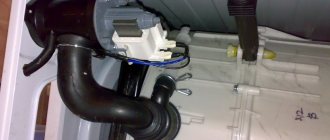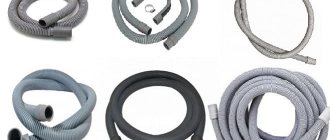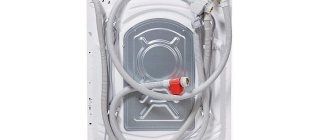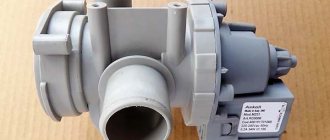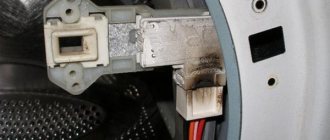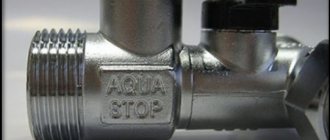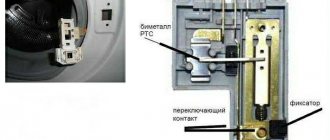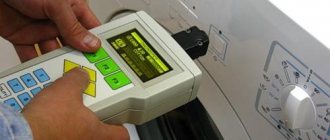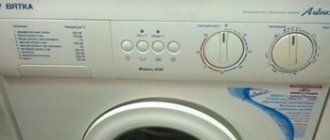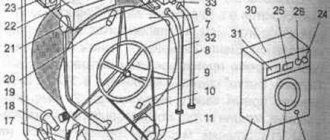How to clean the drain hose in a washing machine. Blockages are the most common problems of the SMA. In case of such a problem, calling a technician or transporting it to a service center is not necessary. It’s quite possible to solve it yourself.
Some people mistakenly believe that you can clear a blockage in a hose by simply rinsing it with running water. In principle, this is true, but first it should be dismantled without damaging it, and then installed back.
- Causes of clogs in washing machines
- Signs
- Cleaning without disassembly
- Dismantling in different models of washing machines
- Flushing
- Preventing blockages
- SMA catalog with reviews
How to get to the pump
To clean the pump, you need to get to it. This part is hidden inside the device body and therefore you will have to disassemble the machine. For this work, prepare in advance a set of the following tools:
- Phillips screwdriver;
- flat screwdriver;
- wrench;
- deep container for draining water.
You need to know that in different models of different brands you will have to get to the pump in completely different ways. If you are interested in the question of how to clean the pump in an LG washing machine, then you should know that in order to gain access to the pump you will have to remove the bottom of the case. It unscrews quite easily. Machines from the Indesit, Samsung, Whirpool, and Ariston brands are distinguished by the same valuable repair quality.
Before proceeding to remove any element of the housing, do not forget to disconnect the device from the power supply and also shut off the access to water.
Next, proceed step by step:
Locate the panel at the bottom of the case and, armed with a flat-head screwdriver, open it. Sometimes such manipulations are not required, because in some models the panel is replaced by a freely opening door; Also, use a screwdriver to unscrew the screw that secures the filter in the bottom of the device; Then you will need to tilt the machine forward a little and place a deep container under the filter plug to collect water or put a thick, dry rag; Remove the filter and wait until all the water flows out of its hole; Gently grasp the pump and begin turning it counterclockwise. In this case, you need to try to slightly push the pump inside the device.
As soon as you feel that the pump has given way and slightly “sunk” in the machine, carefully pull it and pull the pump out through the bottom. To make the work more convenient, the unit can be placed on its left side before removing the pump.
To completely remove the pump, all you have to do is disconnect the wires, loosen the clamps and remove the pipes.
By the way, these instructions for removing the pump will be useful to owners of household appliances who would like to know the answer to the question of how to clean the pump in the Indesit, Ardo, Virpul, Ariston, Samsung washing machine.
Where is this element located?
If you believe a superficial social survey conducted by our campaign specialists, approximately every twentieth washing machine user does not even know where his “home assistant” has a garbage filter. It’s clear that such a user never thought about cleaning the filter. For those who are not in the know, let us tell you that the garbage filter of the LG washing machine is located in the lower right part of the case (almost in the corner) hidden by a special hinged lid.
The lid opens very easily, just grab it with your thumb and pull it slightly towards you - it will fold back right away! Right under the lid you will see two elements: a large round filter (its visible part) and a thin black hose for emergency drainage of water from the tank. The hose is securely closed with a plastic plug, which will have to be pulled out if you want to urgently remove water from the tank if the washing machine breaks down. Water from such a hose flows slowly, which means that emergency drainage will take a long time, but it’s better than nothing.
The garbage filter of the LG washing machine is pulled out by twisting it, which is why it has a rather convenient handle, by grabbing which the filter can be easily removed.
Preparatory procedures
You cannot immediately unscrew the garbage filter of the LG washing machine in order to clean it. The reason is very simple - unscrew the part and water flows through the hole onto the floor. Moreover, in this case, the water flows quite vigorously, quickly emptying the washing machine tank. There is a relatively small amount of water left in the tank after washing, but it is dirty. And if, for example, there is a mat near your washing machine and you did not remove it before starting to clean the filter, then you will also be provided with washing the mat.
So, whatever one may say, even such a simple procedure as cleaning the filter of an LG washing machine requires a little preparation. Preparation will consist of the following actions.
- Just in case, disconnect the washing machine from the power supply.
- Remove rugs, carpeting and any other items that could be damaged by water away from the machine.
If there is moisture-sensitive flooring underneath your washing machine, take steps to ensure it is not damaged by water. It is best to lay cellophane and lay rags on top.
- Stock up on rags and a suitable low container, such as a plastic trough or frying pan. When specialists unscrew the garbage filter, water flows not onto the floor, but into a previously prepared container.
- Tilt the washing machine back a little so that its front legs are off the floor and place a container under the body, just under the place where the filter is located.
- Place rags around the container and you can begin the process of cleaning the garbage filter of your LG washing machine.
Dismantling the pump through the bottom of the MCA
This design is typical for the brands Whirlpool, Indesit, Samsung, LG, Ariston, Beko, Ardo, Candy. Access to the pump is considered the easiest.
Do this:
- To remove the pump, you can tilt the washer backwards. But if there is no one to hold the equipment, then it is better to lay it on its side. First check if there is water in the powder receptacle.
- If the bottom of the machine is covered with a panel, unscrew the screws and remove it.
- Having approached the pump, loosen the pipe clamps and disconnect them from the pump body.
- After disconnecting all wiring and unscrewing the mounting screws, remove the pump.
After dismantling, the part must be cleaned. Read about it below.
Types of possible blockages
In order to make the right decision in time and eliminate possible blockage, it is necessary to find out what type of plug could cause the water obstruction. Therefore, before clearing the blockage in the drain pipe, you need to check whether the water is draining in the bathroom or shower stall, in the toilet, or in the kitchen. Only after this can you decide on the type of blockage and, accordingly, on the methods and means of removing them.
There are several types of blockages.
1.1. Operational
We are talking about a clog of greasy origin, which most often forms in the kitchen drain during cooking or when washing dishes, since various liquid fatty mixtures are poured into the drain hole. Moreover, these fatty deposits on the inner surface of the pipeline begin to attract hair, food waste and other dirt. How to flush the drain pipe in such cases? The best way is to use chemical reagents.
1.2. Mechanical
Traffic jams of mechanical origin most often appear due to the fault of the residents of an apartment or house. It's no secret that most of us throw toilet paper into the toilet (and children can even tear off several large pieces!) Therefore, not all the paper is corroded by water, which leads to frequent clogging.
To prevent this type of traffic jam, many families practice throwing used toilet paper and other hygiene items into the trash can located near the sink.
How to clean the drain pipe in such cases? The ideal option is to prevent such blockage, but if this happens, then this problem can be solved with the help of a plunger or a plumbing cable.
1.3. Technogenic
It happens that if the sewer system is not designed correctly, a pipeline becomes clogged. This type of blockage is the most difficult. And from a financial point of view, it’s not entirely pleasant, since the apartment was put into operation, and all the problems that arise must be solved yourself. At the same time, it is impossible to eliminate the obstruction either with a plumbing cable, or with a plunger, or with chemicals. Therefore, it is often necessary to even dismantle part of the sewer system in order to correct the builders’ mistakes.
1.4 Clogged siphon
The most important component of the structure, with the help of which used water is discharged into the sewer system, is the siphon. This device serves as a connection between the kitchen sink or bathtub drain and the sewer system.
Thanks to this device, we do not smell unpleasant odors.
Although, over time, the siphon container fills with fatty deposits, which become more and more every day. It is very easy to get rid of siphon blockage with your own hands.
To do this, you need to remove the lower part of the siphon, take hot water, add a little dishwashing liquid and thoroughly wash out the deposits that have formed.
Rules for caring for your washing machine
If you regularly take care of your assistant, you can do without disassembling the structure and unscheduled replacement of its elements. And to do this you just need to follow a few simple rules.
To prevent an unpleasant musty smell and mold from appearing in the washing machine, try to keep the drum open, and close it when taking a bath or shower.
Recommendations and useful tips for care:
- After washing, always wipe the door glass, drum and rubber band dry, and rinse the powder container under good pressure with warm water and dry.
- If you have hard water in your area, you can equip the water supply hose to the machine with a magnetic filter. The flow will pass through a magnetic field and change the crystalline structure of the water, as a result of which scale simply does not form.
- Wash blankets, sweaters and other fleecy items in a special fine-mesh bag.
- Do not leave wet clothes in the washing machine even for a couple of hours - in addition to the unpleasant smell, the consequences of such forgetfulness will soon appear as black mold spots.
- Promptly remove powder stains, water drips and grease splashes (applies to appliances installed in the kitchen) from the appliance body.
Depending on the time the stain appears, the options for getting rid of it will differ. To remove fresh dirt, simply wipe the plastic with a cloth soaked in water or a solution of dishwashing liquid. And baking soda paste will help deal with old yellow spots and stains.
The frequency of preventative cleaning with home or professional products depends on the quality of the water in your system, the use of softeners and how often you use the washing machine.
On average, the procedure for disinfestation and descaling should be carried out once every 2-3 months. And do not forget to rinse the filter and drum cuff to remove lime particles after all cleaning compounds.
What happens if you neglect cleaning?
The process of cleaning the filter in LG washing equipment is described in detail in the accompanying documentation for the device. Many people, leafing through the instructions, ignore this maintenance item, but in vain, because a dirty drain filter can cause the user a lot of serious trouble.
- Smell . Threads, hair, fabric fragments plus constant humidity are an ideal environment for bacteria to live. If you forget about cleaning, very soon the filter will turn into a local cesspool and become a source of unpleasant odor, which will inevitably penetrate into the drum. It’s unlikely that anyone will like it if freshly washed items have the smell of stale laundry.
- Problems with drainage. A clogged drain filter is an obstacle to water flow. With each wash, the water will drain more and more slowly, and later it will stop altogether. Then errors will begin to appear, and then it won’t be long before repairs are made.
- Pump failure. Increasing the load on the pump can cause it to overheat and fail. In addition, some of the contents of the filter may penetrate into the pump, which will cause the impeller to jam.
A dirty water supply filter is guaranteed to cause slow flow of water into the device, or its complete cessation. The result is an increase in the time spent on washing and a number of errors that periodically appear on the screen.
How to clean the drain hose?
After disconnecting the hose, it must be inspected visually and cleaned. To properly clean the hose, you need a thin Kevlar cable. Using a small brush at the end of the cable, you need to clean the deposits inside the hose.
Clean the hose as follows:
- First you need to insert the cable inside the hose. And first on one side, and then on the other,
- Perform the above procedure as many times as necessary for proper cleaning,
- Wash the hose under a strong stream of water,
- Fix the hose in its old place,
- Reassemble the machine in reverse order.
How often is it needed?
Frequency of the procedure, according to the manufacturer’s recommendation: every 3-6 months . But this is conditional - the prevention time depends on the frequency of turning on the device, the weight of the loads, and the degree of soiling of the laundry. In large families with children, the car is turned on every day, so it is serviced once a month.
In winter, warm, fluffy items made of wool, flannel, and flannel are washed - the element quickly becomes clogged with fabric substrates, so they clean it more often. The machine is cleaned immediately after washing natural down jackets and feather pillows.
Cleaning the drain hose
The problem can be solved in several ways. Contact a repair shop and try to solve this problem without the help of a technician. After all, he will not come right away. You will have to wait for his arrival, and the laundry will gradually accumulate. In principle, most washing machine owners can clean the drain hose. This work does not require special knowledge or professional skills.
Blockage
A clog is defined as a buildup of debris that prevents fluid from draining from the hose. It is divided into several types:
- Mechanical. The filtration system is clogged. Various small objects, such as buttons, often end up here.
- Natural. When washing, the drainage system begins to clog. Hair and various small particles accumulate inside. As a result, the hose becomes impassable.
A blockage can be called a powerful drain blocker. As a result, the washing machine does not operate in the established modes.
Signs of a clogged drain pipe
When a blockage appears, the program begins to go wrong. This is determined by the following criteria:
- indicators start flashing;
- the speed of the drain flow decreases;
- the machine begins to hum loudly;
- The touch panel does not work;
- there is a constant shutdown;
- The electronic system is triggered, the machine turns off at the moment of draining.
- Instead of draining, the “rinse” mode is activated.
To deal with the problem yourself, you need to first familiarize yourself with the design of the washing machine and understand how the drain system works. The manufacturer provides all the information you are interested in in the instruction manual.
How does the drain system work?
Before the final drainage begins, the water enters a storage tank connected to a cleaning filter, where all kinds of small particles and small lumps of dirt settle.
After purification in the filter, water is supplied to the impeller. Only after this does it begin to drain. The impeller, rotating at high speed, creates pressure that pushes water through a flexible hose. A blockage may occur along this path, in any area.
Features of the drain system of a constructive nature
Before you start troubleshooting this type of problem, you should theoretically understand the structure of the drainage system of the washing machine. In the design of new models, the used liquid from the drum is transferred to a special fitting.
The outlet pipe is connected to a cleaning filter, onto which all dirt and small contaminants coming from the water from the drum are deposited. The used water, passing through the fitting and filter, enters the pump. And in it, under the influence of pressure that appears as a result of the constant rotation of the impeller, it flows through a hose into the sewer.
The outlet channel of the drainage hose is connected either to a siphon located nearby, or to the sewer system itself. Some people have made it easier for themselves by not connecting the hose to the sewer system, but simply lowering the end into the bathtub or sink.
But blockage is an insidious problem, and it can occur in any part of the drain system. But the task of removing a clogged washing machine is made easier by the fact that most often the clogs occur in the area of the cleaning filter.
Types of blockages and reasons for their occurrence
The appearance of blockages in the drain hose is one of the most common phenomena that can damage the washing machine.
Specialists in service centers for repairing washing machine drains distinguish two types of blockages: regular and mechanical.
Mechanical
The main reason for the formation of mechanical blockages is the entry of foreign objects into the filtration system of the structure.
Most often, the role of such “clogs” is:
- Money coins and small buttons.
- Locks from clothes.
- Bra clasps and underwires.
- Toothpicks, napkins, small toys.
- Money and other contents of pockets.
When foreign objects enter the filtration system, the drainage system is blocked and the washing machine simply stops working.
Ordinary
Apart from the entry of foreign debris, the drainage system of the washing machine can become clogged in other ways, naturally.
This often happens due to the accumulation on the filter of all kinds of fluff, fluff and pieces of cotton wool that were on the machine.
The fur of your pets also remains on all objects, and especially on the machine. And during a new wash cycle of your bedding set, clothes or anything else, wool also gets into the drain hose, where it remains, and after a certain amount of time it becomes tightly clogged in the filter.
A blockage in the drainage system of a washing machine can be identified by a number of obvious signs:
- Reducing the rate of drainage of used liquid (contaminated water).
- A software malfunction occurs when the washing machine does not switch to rinse or spin mode on its own.
- Complete blocking of the unit.
If your washing machine still has an unexpired warranty period, you can easily repair it without any financial investment. But if the problem appears after several years of use, you should try cleaning the system yourself. You can do this simple operation to remove clogs in your washing machine yourself in half an hour.
This is interesting: Grease trap for sinks, for sewerage and hoods - why is it needed, pros and cons
Disconnecting the hose
For different models and types of washing equipment, the drain hose is disconnected in different ways. You will need to remove the drain hose in different ways, since washing machines have special housing design and different methods of securing the drain pump.
However, first of all you need to do the following:
- Disconnect washing equipment from the power supply;
- Turn off the tap through which the water flows, then drain the remaining stagnant water through the hole in the drain filter;
- Pull the hose itself out of the sewer pipe.
When the disassembly tools are ready, you can begin to disassemble the washing machine.
This is done like this:
- First you need to remove the bottom panel using a flathead screwdriver;
- Then you need bolts that will hold the filter;
- Next, for more convenient operation, you need to place the washing machine on its side. First you need to put something under the machine;
- Using a tool, loosen the hose clamp. Then remove it from the pump connection;
- Disconnect it from the fasteners on the machine body.
It should be noted that there are washing machines that do not contain a bottom or have a special removable tray.
This is done like this:
- First you need to unfasten the hose, freeing it from the latches that hold it;
- Disconnect the water supply hose from the valve;
- Unscrew the top panel of the machine, which is held on by bolts on the back wall;
- Remove the top panel (cover) of the machine;
- Remove the back wall by first unscrewing the screws located at the edges;
- Release and remove the hose clamp.
You need to do this:
- From the front part of the machine body you need to remove the clamp, as well as the rubber seal;
- Remove the tray for loading washing powder;
- Remove the bottom bar of the machine body;
- Unscrew the bolts located at the bottom of the panel;
- Remove the door lock;
- Remove the front panel of the washing machine body;
- Loosen the clamp that holds the hose;
- Remove it.
First, the side wall mounting bolts are unscrewed, then the side panel itself is removed. Next, the clamp on the hose is also loosened. The last step is to remove the hose itself.
Hose removal process
Despite the differences in the design of washing machines, the principle of dismantling is common. The hose is connected to the pump and exits through a special hole in the rear wall. Less commonly, there may be an adapter on the back wall to which the hose is connected. We analyze the equipment in the following order:
- We remove the desired wall. Depending on the manufacturer, it is necessary to remove the front, rear side cover or floor of the washing machine.
- Loosen the clamp securing the hose to the pump.
- Disconnect the drain hose from the pump.
- Remove the fastening of the part to the rear wall. In some models this is not required, since the back wall is removed during disassembly to access the pump.
If you need to remove the front cover to access the pump, you must first carefully remove the detergent container. As a rule, it is attached to a plug, which will be accessible when the powder container is opened.
Some useful tips and operating rules
Sometimes water leaks when cleaning is completed. In most cases, the cause of the malfunction is a poorly tightened filter. In this case, you need to unscrew it again and carefully put it back in place. It is also possible that the gasket was too worn.
It is useful to take measures to prevent blockages. To do this, it is recommended to do the following:
- Filters must be cleaned on a regular basis. In this case, dirt will accumulate in them to a minimum extent.
- You need to inspect the clothes being washed and the water for small objects that could clog the machine drain. It is necessary to check the pockets and how tightly the buttons are sewn.
- You need to choose the best quality laundry powder and conditioner available to use.
- If you need to wash clothes that have small parts (for example, beads), it is recommended to do this in a special bag.
Proper care of equipment will extend the life of the washing machine.
How to clean a drain hose by disassembling the drainage system
Sometimes cleansing indiscriminately does not produce positive results. To remove the blockage, you will have to disassemble the drain system. The work must be performed in a certain sequence, in compliance with safety requirements:
- before proceeding with disassembly, the device must be disconnected from the electrical supply;
- turn off the water;
- remove the drain hose;
- put the product on its side, having previously laid it with a soft cloth.
To work you will need several tools:
- screwdriver;
- pliers;
- thin brush.
The disassembly operation is performed in accordance with the technological process:
- the bottom panel is removed;
- the filter is released;
- The clamp is pressed out with pliers;
- the hose is released from the pump;
- is removed from the housing.
The disconnected tube must be thoroughly cleaned. Before the operation begins, it must be carefully examined. The presence of cracks, various mechanical damage and other defects is not allowed. A brush tied to a strong fishing line is inserted inside the hose. Carrying out successive movements back and forth, first one side of the hose is cleaned, then the other. After the operation is completed, it is washed with a strong stream of warm water.
If you cannot immediately get rid of the dirt, the tube should be soaked in a solution of citric acid. Leave for two to three hours. Then rinse the hose thoroughly again. Assembly work is carried out in reverse order.
After completing assembly, you need to perform a test wash without loading laundry. To enhance the cleaning effect, you can add a little citric acid to the drum. Anti-scale agent cleans the surface well.
The maximum temperature is set. Working in this mode, complete cleansing of existing scale will occur.
Flushing
It is not difficult to clean the lumen of the removed drainage. First you need to prepare a basin that can accommodate the drain hose. You will need to heat the water to a temperature of 60-70 degrees and prepare the detergent.
Procedure:
- Inspect the tube for integrity.
- Using a long and thin stick, remove any mechanical blockage if present. If this cannot be done, the hose must first be washed and then cleaned.
- Immerse the tube in water, after adding an aggressive detergent, for example, for cleaning stoves, and leave for 30-40 minutes.
- Put gloves on your hands and arm yourself with a sponge.
- Take out the hose, wipe its surface with a sponge and wash with running water.
- Clean the inside.
Are you unplugging your washing machine?Oh yes! No
- Treat the outer and inner parts with detergent, place in a bathtub or empty basin and leave for 20 minutes.
- Clean off any remaining dirt and rinse well under running water.
- Wipe and dry.
- Attach it back to the washing machine, securing it with a clamp.
- Reassemble the device in the reverse order, paying special attention to tightness.
- When the drain hose is installed, run the quick wash mode for preventive purposes.
Expert opinion
I work in the household appliance repair industry. Extensive experience in restoring washing machines and dishwashers.
Ask a Question
Important! Prepare in advance a thick and stiff wire or a thin stick, which can be used to clear the resulting blockage. Its diameter should be no more than ½ the thickness of the hose.
There is another quick option. You need to attach the end to the tap. Turn on hot water under acceptable pressure. Use your hands to stretch and compress the hose corrugation. If the washing machine has been in use for a long time, a lot of deposits will come out, possibly causing a bad odor.
Important point! If there was an extension using a coupling, then it must be disconnected, because congestion often occurs in this area.
Cleaning the hose
After removing the element, inspect it and make sure that it is not damaged anywhere. You will need a thin cable with a small brush at the end - it works great for cleaning soap scum. For careful and effective cleaning, we suggest you use the following tips:
- Make forward movements with the cable, returning it back from time to time. The process is similar to clearing a clogged sewer pipe.
- Rinse the washing machine drain hose under running water.
- Reinstall.
- Assemble the washer, putting all the parts in place.
To consolidate the result, pour 100 g of citric acid into the powder receptacle, set the temperature to 60 degrees and turn on the “idle” mode.
Possible problems and ways to solve them
Expert advice will help you effectively deal with the problem:
- A leak is not always a sign of a broken hose. It is necessary to carefully inspect the entire length of the hose to try to find the location of the break. Leakage can also be caused by wear of other parts.
- Ignoring even a small leak can lead to big problems, including flooding downstairs neighbors, damage to the floor, and serious damage to the washing machine itself. If there is a leak, the problem will only get worse, so it needs to be addressed immediately.
- Lack of skills in repairing equipment is a reason to seek help from a specialist. Inept actions can cause harm.
- When bringing the washing machine indoors from the cold, you need to wait for several hours. Since the remaining water that was in the car and turned into ice can cause serious damage.
- If the length of the factory hose is not enough, it is recommended not to extend it, but to replace it with a new one of the required size. The connection point will not have the required reliability.
You should not leave a running washing machine unattended, as an emergency situation may arise, such as a leak.
Instructions for cleaning the drain hose
The drain hose is disconnected with its own characteristics depending on the washing machine.
For example, when working with equipment from LG, Samsung, Indesit, you need to approach the pump through the bottom:
- Remove the bottom (or bottom panel).
- Remove the filter elements.
- Unclench the clamp and disconnect the drainage system pump.
- Disconnect the hose.
For Electrolux and Zanussi machines the process is different:
- We detach the hose by releasing the special latches.
- Unscrew the hose from the water supply system (valve).
- Remove the top and back covers.
- Unclench the clamp on the drainage system and disconnect it.
With “washers” of the Beko and Siemens brands, perform the following actions:
- Remove the clamp and seal from the front of the housing.
- Remove the container into which the cleaning agent is poured.
- Remove the bottom panel.
- We unscrew the bolts to remove the hatch blocking system.
- Disconnect the front cover.
- Unclench the drain hose clamp and pull it out.
If the machine does not have a vertical method of loading laundry, as in the examples given, but a horizontal one, then:
- Remove the side panel.
- Unclench the clamp on the drain hose and disconnect it.
The hose itself is cleaned as follows:
- We insert the cable into the hose alternately in both directions. This must be done several times.
- We wash the hose with running water.
After the procedure is completed, the hose is attached back to the unit, and itself is assembled in the same order as it was disassembled.
Video: disassembling a technical device and cleaning the drain hose of one of the indicated models.
Carefully monitor the condition of your washing machine. The cause of the breakdown may not only be a clog in the drain hose. Regularly descale it, use proven products and operate the equipment carefully, and then it will serve you for many years. Also, for prevention, try to clean the hose in order to anticipate the problem in advance. A serious clog can send your car to the repair shop and it's best to avoid this.
Preventative work
To prevent blockages in the drain hose of your washing machine, you must always follow a few simple steps:
- The drain filter should be checked once every three months. It is cleaned with a soft brush and washed with a strong stream of warm water.
- Always check pockets before loading items into the car. All detected items must be removed.
- It is allowed to put clothes in the drum, fastened with a zipper and all buttons. Every item must be turned inside out.
- It is allowed to use detergents specified by the manufacturer in the operating instructions.
- You should only use washing powders used in automatic washing machines.
- Delicate fabrics are washed in special mesh bags. To soften the liquid, you should use only the products specified by the manufacturer.
- Descale periodically.
- Install an additional filter on the hose through which tap water is supplied.
- Clean the drain system regularly.
Maintenance does not take much time. But by doing such work, you gain a lot of experience. You will be able to repair the machine yourself if an unexpected breakdown occurs.
If you suspect that a blockage has occurred, you just need to follow the correct algorithm:
- check the condition of the filter;
- clean the hose using chemical compounds;
- disassemble the drainage system.
Any of the above methods will help completely solve the blockage problem.
And a little about prevention
- Use only as much powder, bleach and conditioner as you actually need (see product manufacturer's instructions). After all, excess detergents do not enhance the result, but simply settle and accumulate inside the washing machine.
- Always remove small items from pockets to prevent them from clogging the drain filter.
- Try not to delay starting the machine if you have already thrown dirty things into the drum. Well, take out clean clothes immediately after washing and send them to dry.
- Try to always keep the car open to prevent mold from growing in it due to high humidity.
When to clean filters
Clogged filters are indicated by problems with the washing machine. The most common symptoms that appear are:
- slow intake and drainage of water;
- displaying error codes;
- sudden stop of washing;
- inability to turn on the “Spin” and “Rinse” programs.
If one of the problems is detected, disconnect the unit from the power supply and check the condition of the filters.
Malfunction of the filters is indicated by problems with drainage or water intake, error codes displayed on the display, and the appearance of an unpleasant odor in the drum
Cleaning the drain hose
In this situation, you have two solutions: call the service center, call a technician, or try to fix the problem yourself. You will have to wait a long time for help from a technician, and the laundry will accumulate. Cleaning the washing machine hose yourself is not such a difficult task.
Blockage
A blockage is the formation of obstacles in the form of stuck debris on one of the sections of the drain hose.
At home, you encounter two types of blockages:
Mechanical: small objects (from hooks to buttons and coins) enter the filtration system.
Natural: the smallest particles of clothing, lint, fluff, cotton wool, hair in the hose gradually accumulate in the drainage system, which leads to blockage.
The clog is blocking the drain. As a result, the machine refuses to obey software commands.
Signs of a clogged drain pipe
Software failure: the lights on the control panel begin to flash feverishly; the speed of draining the water sharply weakens, while the machine makes a loud noise; the touch panel goes out, the machine turns off; the electronics turns off the washing machine when you try to drain the water or switch to the “spin” or “rinse” mode.
To fix the problem yourself, you need to familiarize yourself with the design of the drain system of your model. To do this, carefully read the instructions included with the machine upon purchase. Study the design features of your equipment.
The principle of operation of the washing machine drainage system
Before the final drainage, the water first enters a special corrugated pipe (storage) connected to a cleaning filter. The filter “catches” the smallest particles of dirt and objects.
After passing through the filter, the water enters the impeller. The liquid then leaves the washing machine. As a result, the pressure created by the rotation of the impeller enters the sewer through a flexible tube.
A blockage can form on any part of this path.
Start with the simplest steps
Unscrew the filter installed on the machine. In most models it is located at the very bottom of the front panel. Check for objects that have fallen into it. If the filter is clean, then you should check the drain hose.
In this case, there are two options for resolving the problem:
- without disconnecting the drain tube;
- with disconnecting the drain hose, disassembling it, and washing the drain system.
If there is a suspicion that small fibers, hair, or lint have accumulated in the drain hose, it should be cleaned without disconnecting it from the unit. The main task is to dissolve this accumulated debris. Special solutions, powders, tablets purchased at a hardware store will help. Tell the sales consultant about the problem, he will quickly select the right remedy.
Some people prefer the banal method - using baking soda or soda ash.
The recipe is simple but effective:
- It is recommended to take 200 grams of baking soda powder. Pour into drum. The washing machine is set to wash mode (without laundry), the temperature is set to 90 degrees.
- Heated water together with baking soda forms an alkaline solution. The high temperature of the solution instantly removes dirt stuck inside the drain hose.
Online diagnostics of a washing machine
If your machine stops washing or rinsing clothes normally, then some kind of malfunction or breakdown has occurred.
You can try to find the problem yourself. Run diagnostics
Select which operation your washing machine does not perform:
1. Doesn’t drain 2. Doesn’t rotate the drum 3. Doesn’t spin clothes 4. Noises, knocks, buzzes when spinning 5. Doesn’t turn on
Checking the operation of the drain pump Is the drain pump of the washing machine working? Yes No I don’t know << Back
Clogged hoses in the washing machine If the sound corresponds to the normal sound that has always been observed when the device is working, the cause is probably a clog.
Was there a blockage in the drain hose? Yes
<< Back
The drain pump does not work! If the sound matches the normal sound of the drain pump, it is recommended that you check the drain filter first.
After cleaning, does the drain pump work and does the washing machine drain water? Not really
<< Back
Operation of the drain pump The sound of the pump is usually immediately audible and noticeable. If there is no sound, the pump is not working. We are looking for how to separately enable the water drainage program. As a rule, this is a separate option. After the program has been turned on, the pump should start working in 1-3 seconds. If everything is done correctly and the pump is operational, a buzzing sound will appear. If you hear no buzzing or other sounds when you turn on the program, the pump is probably faulty.
Is the washing machine drain pump working? Not really
<< Back
Clogged car hoses If you have identified a clog in the hoses, you need to disassemble them, clean them, and then reassemble everything.
Does the washing machine drain well? Not really
<< Back
Hurray, you did a great job, you fixed it.
<< Return to the beginning of diagnostics
The drain pump is faulty, call a professional.
<< Return to the beginning of the diagnosis.
The washing machine does not rotate the drum. During the operation of the washing machine, such a problem may occur. Each model has a different drum operation. It rotates according to a given algorithm, which is set by the program. This principle applies to spinning and washing. If you are not sure whether the drum is not spinning or whether it is working, put the laundry in the washing machine. Start the spin program. If the machine is running, it will first drain the water and then start spinning. In this case, a rotational process will be observed. If rotation is not visible, then check the belt. First, turn off the program, then unplug the wire from the outlet so that power does not flow into the device. Now you need to remove the back cover. You will need to carefully inspect the drum belt. It is quite easy to determine whether it is in the wrong position or damaged.
Is the washing machine belt torn or stretched? Not really
<< Back
Broken drum drive belt If the belt breaks, it will be immediately visible. There are also often cases when the belt simply stretches, which is why the drum, accordingly, does not rotate. Do not allow the machine to operate if the belt breaks. It is important to check whether it has wound around the engine pulley or broken the wiring to the engine. The heating element and temperature sensor may also be damaged if the belt does catch the wires. It is imperative to ensure that the belt model is original. If you choose an unsuitable or low-quality product, this will affect the performance of other devices. How do you know what kind of belt you have? There will be a marking written on the old one, compare it with the one indicated on the belt offered to you. You can also find out belt information by car model.
<< Return to the beginning of the diagnosis.
Washing machine motor malfunction If a malfunction is not found, the block with wires must be disconnected from the electric motor. Carefully remove it. We visually evaluate the engine. It may have melting, cracks, or other effects that clearly indicate damage. We call the windings of the tachogenerator and the engine. It is important to understand that you can fully study how correctly the engine operates and whether there is a malfunction only at the stand. If rotation does not occur, there may be a problem with more than just the motor. Sometimes the cause is a malfunctioning electronic module. If a short circuit occurs in the engine, the module could be damaged, while the engine remains operational. Also, the wires could be damaged.
<< Return to the beginning of the diagnosis.
Repairing a washing machine that does not spin clothes After completing the washing process, the washing machine may not spin properly or may not start spinning. Firstly, look, perhaps another mode is set, which does not involve turning on the spin cycle at all. This happens, for example, with programs related to washing woolen items and delicate fabrics. To check, run the spin cycle separately. If the washing machine does not drain water, we proceed to check the pump.
Does the washing machine now spin clothes? Not really
<< Back
Congratulations, you have solved your problem!
<< Return to the beginning of the diagnosis.
Repair of washing machines, imbalance Modern washing machines place the laundry on the drum before spinning. This is necessary for quality work. Check if this feature works. Sometimes a situation occurs when things get wrapped up in a ball that cannot be unwound automatically within a certain time. At this point the work stops. You need to unwind this laundry yourself, lay it out and continue operating the washing machine. In this case, it is important to turn off the machine, and then, when the laundry is laid out, turn on a separate spin program.
Does the washing machine now spin clothes? Not really
<< Back
Washing machine repair, drum drive repair Now you need to check the drum drive belt. We remove the cover and visually assess the condition of the belt. There should be no damage. If the tension is weak, the spin may not turn on. If you need to replace the belt, you should only replace it with the original one. After replacing, we try the program again.
Fault found, does the washing machine spin? Not really
<< Back
The engine or electronic module is faulty, call a repairman to your home.
<< Return to the beginning of the diagnosis.
The washing machine hums, makes noise during the spin cycle, rumbles, and makes a jet plane noise. If the washing machine makes noise during operation, making unusual sounds, it’s time to pay special attention to it. In this case, a visible breakdown or lack of functionality may not be observed, but the appearance of strange sounds indicates that it is time to look for a malfunction. It is important to understand that a new car that has just been delivered should be inspected for shipping bolts. If you forget to remove them, noise and vibration are inevitable. So, let's begin! We turn the washing machine drum and listen to extraneous sounds.
When rotating, do you hear extraneous noise, hum, balls rolling, does the drum move unevenly with slight jamming? Not really
<< Back
If the drum rotates and uncharacteristic sounds appear, including vibration, it’s time to check the bearings. If they malfunction, they will have to be replaced.
<< Return to the beginning of the diagnosis.
The counterweight of the washing machine has come loose. The fastening of the counterweights must also be of high quality. If they are “loose”, it’s time to eliminate this defect. In some cases, you can notice that the bolts that secure the stones are completely missing. In this case, the connectors for mounting will be visible. The bolts need to be found and put in place - they probably simply came loose. A rumble heard while the washing machine is operating may indicate that the bolts have partially loosened. To check the bolts, you can simply push the drum. If it is secure, the bolts are fine. If it moves, there is a defect.
Do you hear any noise, clanging or rattling noises when moving the washing machine tub? Not really
<< Back
The counterweight has come off
<< Return to the beginning of diagnostics
Checking the shock absorbers of the washing machine Checking the shock absorbers. If you hear vibration or excessive noise during the spin cycle, there may be a problem with the shock absorbers. Sometimes the washer moves. Now let's check the functionality. Remove the top cover. Click on the tank, move it five to seven centimeters down. A normal reaction will be observed if the tank rises sharply, jumping a little and stopping in its normal place. If this does not happen, the shock absorbers need to be replaced.
Are the shock absorbers of the washing machine working? Not really
<< Back
If a visible defect has not been identified, check whether a foreign object may have entered the machine. Replacing shock absorbers. The problem with shock absorbers wearing out occurs quite often over time.
<< Return to the beginning of the diagnosis.
Replacing washing machine shock absorbers. Malfunction and wear of shock absorbers is a fairly common phenomenon.
<< Return to the beginning of the diagnosis.
The washing machine does not turn on. It is worth trying to find the cause of the problem yourself and fix it. We start by connecting the device to the network. Next, click on the “network” button. In different car models, different indications are triggered: here either the display will start working, or, on the contrary, some other button.
Does the washing machine have an indicator? Not really
<< Back
Hatch lock lock (UBL) You can check it by turning on any of the programs. We choose what we will use. Click on the corresponding button. Don't forget to pay attention to the inclusion. As a rule, the process of activating a function is characterized by the presence of a certain sound, for example a click, with which the device makes it clear that pressing again is not necessary and the machine is already working. If there is no sound, the button may be broken. In this case, the main thing that must be done is to block the hatch and start working. If this happens, everything is fine.
The washing machine is blocking the hatch and the UBL is triggered? Not really
<< Back
Water fill valve malfunction
<< Return to the beginning of the diagnosis.
The washing machine hatch does not lock
<< Return to the beginning of the diagnosis.
No indication Checking the electrical circuit. If you notice that the washing machine does not respond to being turned on, it is first recommended to check the power supply. The outlet may be faulty. Try connecting another device. If the outlet works, you need to check whether the circuit that conducts energy through the washing machine from one element to another is intact. To do this, you will need a multimeter, which will help you fully analyze the ability to respond to an electrical signal at several stages of operation. If there is no network connection anywhere, this is probably the problem. We carry out this manipulation until we reach the electronic module. If we are talking about an old washing machine, here it will look like the device’s program. When you turn on the button, there should be no breaks in the circuit. If the circuit works, everything is fine electrically.
Is the washing machine's power supply OK? Not really
<< Back
Repair of electronic module (unit)
<< Return to the beginning of diagnostics
Contact circuit fault
<< Return to the beginning of diagnostics
Some models enter push-up mode along with water. Perhaps this is the worst option, because... can lead to damage to a number of parts, and as a result, failure of the washing machine.
There is another option. During the wash cycle, the SMA drains and refills water several times. If the machine's software is not very advanced, then water may pour in without draining.
This is fraught with failure of the engine, shock absorbers, and also the module due to network overload. It is also possible for water to spill onto the floor.
Before proceeding to fix the problem, you need to read the instructions for the washing machine. Practice shows that people rarely read it! At the same time, pay attention to what other failures the model may behave in a similar way. First, you need to make sure that the problem is a blockage.
Expert opinion
I work in the household appliance repair industry. Extensive experience in restoring washing machines and dishwashers.
Ask a Question
Attention! Some models from manufacturers Samsung, LG, Indesit, Ariston have a specific fastening for the drainage hose. It connects to the panel on the bottom. To disconnect it, the machine must be turned over.
Bathroom drain
Tube connection diagram
In most cases, the drain hose is connected inside the washing machine directly to the pump. To clean it, you will need to disassemble the washing machine. Even if the drain is connected directly to the back wall, it is better to disassemble it, since there will be another tube from the pump itself to the back wall. From the machine, the drain pipe is connected to the sewer system.
Particular attention should be paid to places where the hose is bent; debris accumulates there especially actively. Depending on the model of the washing machine, there are several options for accessing the pump, and therefore for removing the drain pipe:
Depending on the model of the washing machine, there are several options for accessing the pump, and therefore for removing the drain pipe:
- access through the rear wall;
- access through the bottom of the machine;
- access after removing the front cover;
- access after dismantling the side wall.
In some models there is no need to additionally disassemble the housing of household appliances. For example, some manufacturers do not cover the bottom of the machine with any plugs, and if access to the tubes is through the bottom, then in this case nothing even needs to be disassembled.
Part selection
If you cannot do without replacing the hose, you need to make the right choice. Possible options:
- Standard. Its length can be 1-5 m. This is enough to connect an LG washing machine to the sewer drain in a regular bathroom.
- Telescopic. When compressed, it is 50 cm; if it is expanded, the length will increase to 150 cm. This is a practical solution, since the length of the tube can be adjusted.
However, when fully stretched under strong water pressure, it will vibrate violently. - Bulk. It is represented by several modules, the size of which is 50-55 cm.
For most models of LG washing machines, a hose with an outer hole diameter of 27 mm and an inner hole of 21 mm is suitable. To accurately determine the size, you need to know the SMA brand. You can find out more information in the user manual.
If it is not possible to purchase an original, then before purchasing you need to take measurements of the old part . This will allow you to make your choice.
Types of filters, where they are located, signs of their clogging
There are two of them:
- Jellied. It is also the entrance, mesh. It is located on the top of the back wall, immediately below the hose that pumps liquid from the water supply into the machine. It is a mesh. It clogs less often, but if this happens, the wash cycle starts slowly and problems occur with pumping liquid. As a result, there may be an error on the display.
- Drainage. It gets clogged quite often because a lot of particles and lint from the laundry being washed get into it. Its location is usually at the bottom, on the right. For the convenience of users, access to it is open, only blocked by a removable cover.
How to clean the drain filter in an automatic washing machine yourself
First, you should disconnect household appliances from the power supply and from the main water supply. Then pull out the filtration apparatus and do this:
- We remove large debris.
- Use a sponge to wipe off the surface layer of plaque.
- If necessary, we use special formulations or folk remedies.
- Wash the device under warm tap liquid.
- Separately wash the hole using a damp cloth.
After this, the cleaning equipment must be installed back and the functionality of the equipment must be checked by connecting it to the power supply.
Where is the drain filter located in the Veko, Indesit, Bosch and other brands of washing machines?
The most common location is bottom right, as in the photo:
There are other places, for example, for the brands LG, Candy, Whirlpool it is located at the bottom edge of the case on the left. Electrolux and Zanussi equipment with top loading are even more difficult to repair and clean. You need to look for the valve inside the drum.
More rarely, traps are not installed at all. These are small-sized and very inexpensive models. You can meet them quite rarely.
How often do you need to clean the drain filter in a washing machine?
Manufacturers give recommendations: at least once every two to four months. In practice, many users clean every six months. It is also necessary to focus on the following indicators:
AMETHYST - 02 M Residential building for up to 10 people or up to 2 cubic meters/day.
Aeration unit AS-1054 VO-90
Main table dispenser AquaPro 919H/RO (hot and cold water)
- Regularity of washing. The more there are, the more often it is worth checking.
- Type of fabrics. Flannel and wool create a lot of litter. Cotton, silk, linen, synthetics - much less.
- Rigidity. High mineralization leads to rapid formation of deposits.
Problems when disassembling the system
When the drainage has not been cleaned for a very long time, it is difficult to unscrew the filter from the hole, because scale has formed on the threads. You can do one of the following:
Use pliers
Using a tool makes it easier to turn the handle, but it is important not to overdo it so as not to break it off completely. Remove the entire pump. To do this, you will need to unscrew the back or front wall, depending on the design of the model
Cleaning will be done from the side of the pipe, and after that you can repeat the unscrewing.
The drainage unit is not so easy to get without skills, so in this case it is better to invite a repairman.
How to clean a filter through a pump
If you still decide to resort to this method yourself, follow the instructions according to the model:
- With access from the bottom. Place the machine on its side. Locate the pump near the edge of the housing. This is not always suitable; sometimes access is difficult due to a steel bar for the shock absorber, like the Bosch brand, or is blocked by an “aquastop” sensor.
- With dismantling the rear wall. Remove it by unscrewing 4 screws and gain access to the drainage. It's so easy to get to the node in Ardo models.
- With the front panel removed. This is the most difficult process, but some devices from Bosch and Siemens leave no choice. Remove the entire façade.
When you have removed the clogged part, proceed in the following steps:
- Disconnect power from the pump.
- Spread a floor rag under the snail to drain off excess moisture.
- Remove the pipe coming from the pump.
- Remove the hose.
- A hole is formed - clean the glass of the filter equipment through it.
The work algorithm is similar:
- Turn off electrical power.
- Remove the supply, disconnect the pipe through which the supply flows.
- Using pliers, rotate the mesh filter device and pull it out.
- Remove the mesh from the cylinder.
- Clean the cells with a toothpick, soak the surface itself in a solution of vinegar or soda, and rub with a toothbrush.
- Carry out installation in reverse order.
What filter elements are included in LG?
The machine has two filters: for water supply and drainage. Where to find them:
An inlet (drainage) filter in the form of a fine mesh is installed at the valve that connects the machine to the water supply.
Located at the top right side of the rear of the machine.
- The drain filter element, which prevents small fragments from entering the drain pump, is located at the bottom of the washing unit, closer to the left edge.
On modifications with vertical and horizontal loading, the location of the elements is approximately the same.
How to clean a drain hose with your own hands
If you do find a malfunction that arose due to a clog in the drain hose of the washing machine, then first of all you need to ensure full access to the drain system.
Cleaning the filter
The filter system is located at the bottom of the washing machine, on the right, behind a small door with a hatch. In order to open it, you need to pry the edge of this hatch with your fingers or some kind of flat, blunt object. In some models, the panel can be opened by pressing the latch or by bending the rotary hooks.
Clean the filter in the following sequence:
- Unscrew the screw and carefully remove the filter.
- We tilt our structure, drain all the available liquid, having previously placed a container with low sides for this purpose.
- After there is no water left in the machine, we remove all foreign objects that are stuck. If structural elements are completely covered with scale, they must be completely replaced.
- Next, when you have already removed the dirt by washing with water and wiping with a damp sponge, inspect the place where the filtration system is located and remove the remaining dirt from the walls.
- Clean the pump and the adjacent system, and then connect your device to power and enable the drain mode. If you did everything correctly, the blades and impeller of the pumping system will rotate without interruption.
All the details can be found in the video review, which describes the process in detail.
Attention: there are exceptional situations when the system is so dirty that it simply cannot be removed. In this case, it is recommended to remove one wall of the washing machine and carefully clean the filter from the side of the pumping system.
Disassembling the drain pipe
It is also possible that the flow of liquid will simply be blocked, even just at the junction with the sewer pipes. To clean the drain in this case, you need to disconnect the hose.
Everything is carried out in several stages:
- Unplug the washing machine.
- Close the water supply valve.
- Using a flathead screwdriver, remove the side or front bottom panel.
- Pour the remaining used water through the drain filter.
- Using pliers, disconnect the end of the hose from the sewer pipe or trap.
In devices from brands such as VEKO, Ariston, Candy, Samsung and Indesit, you can only get to the drainage hose through the bottom. In such cases, to make it easier to clean the washing machine from blockages, place your unit on its side, placing some cloth under it in advance. After you open the clamp with pliers, you can safely disconnect the hose from the pump.
In Electrolux or Zanussi washing machines, the hose runs along the back wall. To get to it, remove the back cover of the case. Next, we open the latches, unfasten the drainage hose, and then unscrew it from the water supply hose. To completely remove the drain hose, you should completely remove the top cover by unscrewing all the bolts and loosening the clamp to secure it.
In machines such as Bosch and Siemens, you can get the hose by removing the front panel of the case. Everything is done in the following order:
- Remove the sealing rubber from the front panel and unclench the clamp.
- We take out the bottom panel and the retractable tray for detergents.
- Unscrew the bolts to secure it and remove the hatch door lock.
- Remove the front panel of the case.
- Unclench the clamp and pull out our hose.
Cleaning the washing machine drain hose
Clean the drain hose by washing and treating the walls from the inside using special brushes. Masters in this business are accustomed to using not metal brushes, but those made of synthetics.
To clean the walls from the inside, the cable is inserted into the contaminated hose and moved back and forth. After this procedure, you need to rinse the hose with water. If the contamination cannot be removed the first time, the procedure should be repeated.
Helpful advice: in order for you to achieve the best effect when washing, use warm water with citric acid added to it.
The hose, washed from all sides, just needs to be fixed in its old place, performing all the described steps in reverse order.

